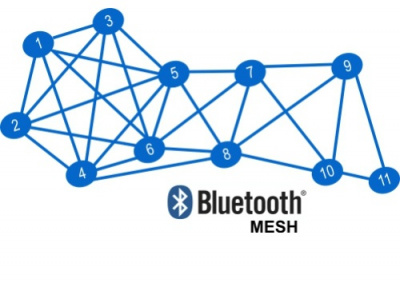An Industrial-grade Bluetooth LE Mesh Network Solution
From iis-projects
Short Description
Routing is a critical issue in packet-switched networks, such as Bluetooth Low Energy (BLE) meshes, due to its significant impact on the network performance. The BLE Mesh Working Group has adopted a Flooding protocol for the first release of the SIGmesh. Our preliminary throughput analysis of Flood meshes raised several concerns for industrial applications: 1. Scalability: A mesh network is scalable if it can cope with networks of different sizes and topologies. Our analysis has shown significant throughput gaps between Flooding vs. Optimal routing for the ‘Many-to-One’ use case, i.e. sensor nodes transmitting data periodically to a network gateway (which is a default use case in many industrial applications). 2. Real-time adaptability: A robust mesh network solution is able to adapt to network changes such as poor link quality or temporary changes in network topology, e.g. adding gateway-capable BLE devices such as smartphones on-the-fly. While Flooding is inherently robust as messages are essentially repeated by all nodes, its adaptability is limited to a single parameter referred to as Time-to-Live (TTL) to change its routing patterns. 3. Latency: While the latency of periodic sensor data and status information in the ‘Many-to-One’ use case can be addressed with appropriate time stamping, minimizing network latency when transmitting critical control messages (e.g. on/off switch) has not been addressed specifically in SIGmesh. While SIGmesh is suited for residential applications, the aim is to address the above shortcomings by introducing a QoS Model and a novel routing algorithm based on a neural network model to ensure industrial-grade BLE networking solutions; our solution is based on reinforcement learning approach, thereby maximizing the expected throughput and enforcing decentralized decision making by each BLE node to find its optimal route in real-time.
This project is done in collaboration with Honeywell Switzerland.
- Familiarize with the Bluetooth Low Energy specification, including Mesh
- Perform state-of-the-art survey on BLE routing algorithms, including Honeywell’s proprietary algorithm
- Identify critical network performance parameters to be integrated in the system design
- Implement a BLE mesh reference system by compiling Nordic’s SIGMesh stack onto the Thingy52 IoT dev kits (or similar) and benchmark the network throughput and latency for different scenarios
- Define the embedded system architecture to implement the novel BLE networking algorithm
- Implement the new algorithm on the Thingy52 IoT dev kits (or similar)
- Evaluate the network throughput and latency performance for different scenarios for both network implementations
Status: Available
- Looking for Semester and Master Project Students
- Supervisors: Michele Magno
Prerequisites
(not all need to be met by the single candidate)
- Experience using the laboratory instrumentation - signal generators, oscilloscopes, DAQ cards, Matlab etc.
- Basic knowledge of communication systems
- knowledge of microcontroller programming (C, MP-ARM, ARM-Cortex-M, Nordic BTLE)
- basic knowledge on signal processing is a plus.
- plus is knowledge on printed circuit board (PCB) using Altium.
Character
- 25% Theory
- 55% Implementation
- 20% Testing
Professor
Detailed Task Description
Goals
Practical Details
Results
